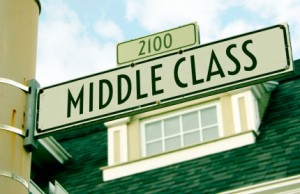 Steve Thorngate’s October Christian Century article, “Defining the Middle: The Rhetoric and Reality of Class,” challenges readers to reconsider what middle class means and who should be included in such a group today. Based on household income data available from the U.S. Census Bureau, Thorngate argues that the current political rhetoric suggests that 83% of households are middle class. He arrives at this number by excluding those below the poverty line (15%) and those with incomes in excess of $250,000 (2%). The poor, those with incomes lower than the middle class, qualify for safety-net government assistance. The rich, those with incomes exceeding the middle class range, are considered rich primarily for having incomes greater than the limit both candidates for President have used when discussing tax reform and its impact on the middle class.
Steve Thorngate’s October Christian Century article, “Defining the Middle: The Rhetoric and Reality of Class,” challenges readers to reconsider what middle class means and who should be included in such a group today. Based on household income data available from the U.S. Census Bureau, Thorngate argues that the current political rhetoric suggests that 83% of households are middle class. He arrives at this number by excluding those below the poverty line (15%) and those with incomes in excess of $250,000 (2%). The poor, those with incomes lower than the middle class, qualify for safety-net government assistance. The rich, those with incomes exceeding the middle class range, are considered rich primarily for having incomes greater than the limit both candidates for President have used when discussing tax reform and its impact on the middle class.
So What?
Thorngate believes that any attempt to suggest 83% of U.S. households are middle class “defies common sense.” Furthermore, allowing for a middle income bracket that spans such a wide range inappropriately suggests that those households earning $40,000 a year and those earning $200,000 a year are of the same economic class. In reality, “the two live in fundamentally different economic worlds.”
- How do you define “middle class”?
- What is your initial response to Thorngate’s suggestion that while no solution is simple, any solution should include a “simple rhetorical shift” that names those households with six figure incomes as rich?